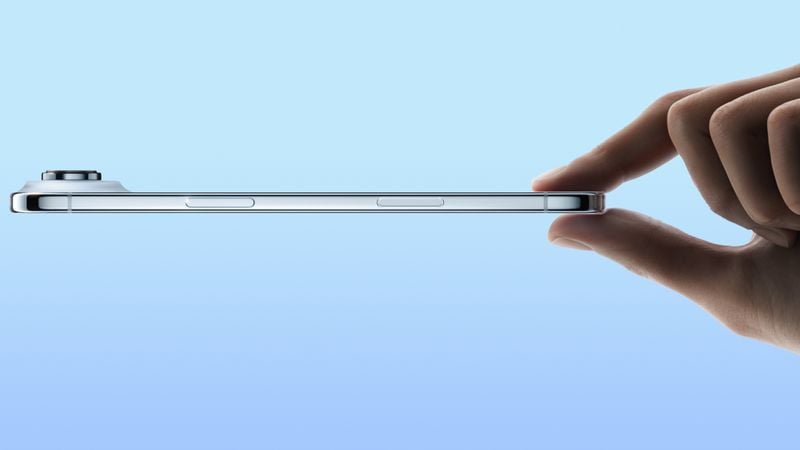Apple is reportedly drastically reducing production of its new iPhone Air model following a market survey that revealed “virtually no demand” for the device. The move highlights the challenges even tech giants face when launching mid-tier smartphones in a market saturated with competitors and price-sensitive consumers. According to industry insiders, Apple’s decision could reshape its product strategy and has already sparked concern among suppliers and investors alike.
iPhone Air: The Model That Missed the Mark
Introduced with high expectations, the iPhone Air was positioned as a lightweight, lower-cost alternative to Apple’s flagship iPhone Pro and Pro Max lines. Key features included:
- Thinner and lighter design
- Smaller OLED display
- Reduced camera capabilities
- Lower starting price relative to Pro models
The goal was to capture mid-range smartphone buyers who could not afford Apple’s premium devices, while competing with high-end Android models from Samsung, Google, and Xiaomi.
However, early consumer surveys suggest the Air has failed to generate the excitement Apple hoped for. Industry sources indicate that purchase intent among target demographics is extremely low, with many consumers preferring either older iPhone models or competitively priced Android devices.
Production Cuts: Scale and Scope
Reports indicate Apple is slashing iPhone Air production by up to 50% for the first half of the fiscal year, a move that signals a significant reversal in strategy. Suppliers in Asia have already been informed, prompting adjustments in component orders for displays, batteries, and chips.
Analysts note that Apple is particularly sensitive to inventory buildup, as unsold smartphones can lead to markdowns and reduced profit margins. By cutting production early, Apple hopes to avoid surplus stock, maintain pricing power, and refocus on higher-demand models like the iPhone 15 Pro.
Market Saturation and Consumer Behavior
The iPhone Air’s struggles reflect broader trends in the smartphone market:
- Consumer Upgrades Slowing: Many iPhone users are holding onto their devices longer, often upgrading every three to four years instead of annually.
- Android Competition: Mid-range Android smartphones now offer comparable performance, cameras, and battery life, making the Air less compelling.
- Inflation and Cost Sensitivity: Price-conscious consumers are less willing to pay Apple’s premium for a device that feels like a stripped-down version of the flagship model.
- Feature Redundancy: Some of the Air’s differentiating features—like a smaller display or lighter frame—have not resonated with consumers who increasingly value camera quality and performance over size or weight.
“Even Apple cannot ignore the reality of market demand,” said an industry analyst. “The Air was intended to fill a niche, but surveys show the niche may not exist.”
Implications for Apple
The production cut has several immediate and long-term implications:
1. Supply Chain Adjustments:
Apple’s suppliers, especially in China and Taiwan, face lower orders for iPhone Air components, which may impact revenue and staffing forecasts.
2. Revenue and Profit Projections:
While the Air was expected to drive incremental revenue, Apple now faces potentially lower-than-expected quarterly earnings if the Pro models cannot fully compensate for Air’s underperformance.
3. Strategic Refocus:
Apple may pivot marketing and production resources toward higher-demand flagship models and services like Apple Music, iCloud, and AI-powered features.
4. Brand Perception:
Consumers may view the Air as a failed experiment, though Apple has historically rebounded from product missteps by emphasizing innovation and ecosystem integration.
Lessons from Past Apple Launches
Apple has faced similar challenges with mid-tier or experimental devices before:
- iPhone SE (2016): Initially struggled with demand but gained traction later due to affordability.
- HomePod Mini: Sold modestly at launch, eventually finding success through ecosystem integration.
- iPad Mini: Iterative upgrades were needed to maintain market relevance.
These examples suggest Apple may reassess the Air’s design or pricing rather than abandoning it entirely.
Investor Reactions
The news of production cuts has already prompted investor caution:
- Apple’s stock experienced slight volatility in after-hours trading following the report.
- Analysts are revising sales projections for FY 2025, anticipating a smaller-than-expected contribution from the iPhone Air.
- Long-term optimism remains for Apple’s overall ecosystem, but investors are watching for how quickly the company can adjust its production and marketing strategy.
Looking Ahead
Experts predict several possible paths for the iPhone Air:
- Price Reduction or Promotions: Apple could offer discounts to stimulate demand.
- Hardware or Feature Refresh: Enhancing camera or performance could make the Air more appealing.
- Integration With Ecosystem Services: Bundling with AppleCare+ or iCloud may attract mid-tier users.
- Limited Release Strategy: Producing smaller batches in response to confirmed demand to reduce inventory risk.
Apple’s ability to adapt quickly will determine whether the Air becomes a temporary misstep or a case study in product strategy.
Conclusion
The iPhone Air production cuts signal a rare strategic retreat by Apple, illustrating that even the world’s most dominant tech company must respond to real-world consumer preferences. While the Air was designed to capture a new segment, surveys indicate that the market simply isn’t interested—at least for now.
For Apple, the challenge is clear: balance innovation, production, and consumer demand while maintaining its reputation for quality and desirability. The coming months will reveal whether the Air can be salvaged or if it becomes a cautionary tale in Apple’s otherwise stellar product history.







